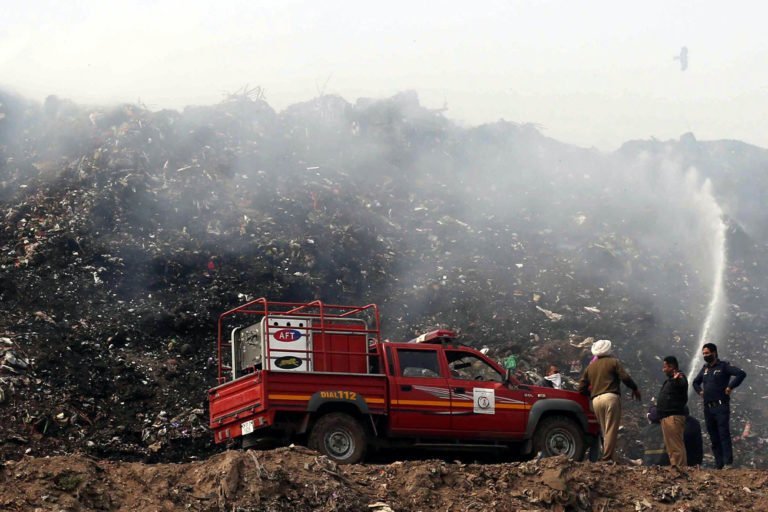The capital city Delhi’s giant garbage mountains often come into the limelight, reflecting India’s poor waste management situation. But a similar scene, not too far away from the capital, in Chandigarh, is another glaring example of the country’s perpetual struggle to manage waste and stop the illegal dumping of waste.
Chandigarh in fact has a legacy of innovation from waste. The planned city, was developed by famous French architect Le Corbusier, who set an example when, in the 1950s, he converted a dirty sewer into a thriving lake. Later, a government employee, Nek Chand Saini, developed a sculpture garden in Chandigarh, now famous the world over as Rock Garden, using industrial and home waste besides other discarded items.
Now, however, a garbage dump is growing in the Dadumajra village on its periphery. The waste site was in the news recently after it caught fire earlier this month. The fire in Chandigarh on April 7 engulfed the surrounding areas in thick smog with a large number of residents complaining of acute breathing problems and skin irritation. There had been a similar fire incident at the dumpsite in 2021 that lasted a week and covered half of the city in a haze, hindering visibility and causing respiratory issues.
An official of Chandigarh Pollution Control Board (CPCC) told Mongabay-India that fires are very common at dumpsites especially during the summer season because of the methane gas trapped there. The dumpsite, he added, is a perfect breeding ground for methane due to the decomposition of biodegradable or food waste over time and it quickly catches fire when it comes into close contact with anything combustible. Potential of catching fire increases in summer because of high temperatures.
The Solid Waste Management Rules issued by the Centre in 2016 state that only non-recyclable, non-biodegradable and non-combustible waste should go to a dumpsite. However, hundreds of tonnes of biodegradable and combustible waste are still dumped at the site every day. The towering mountain of garbage, as per government data, houses more than 1 million (10 lakh) metric tonnes of mixed refuse. This has piled up over the years because of improper waste segregation and processing.
The Chandigarh Municipal Corporation in its report submitted to CPCC dated April 9, 2022 is claimed to have taken corrective measures to stop recurrence of fire incidents. The steps include compacting the waste with thick soil cover, which according to authorities, acts as fire suppressant.
Landfill fires are common this season as other than Chandigarh’s Dadumajra fire, the Ghazipur landfill in Delhi caught fire multiple times this month and another dumping ground, not too far away, in Punjab’s industrial town Ludhiana, too, caught fire on April 17.
Around 62 million tonnes of waste is generated annually in the country, according to the Ministry of Environment, Forest and Climate Change data released in 2016. Out of this, only about 75-80% of the municipal waste gets collected and only 22-28% of this waste is processed and treated. The remaining ends up in dumping sites.
Fire incidents in landfills, a health hazard
The Chandigarh Fire Department, in a reply to a Right to Information (RTI) request by city resident Amit Sharma, dated June 29, 2021, revealed that 486 fire incidents have taken place at the Dadumajra dumpsite in the past 15 years.
As per media reports, Chandigarh has so far used over 40 lakh litres of water to douse fire at Dadumajra waste dumpsite in the past six years. In 2020, eight lakh litres of water was used as fire tenders made 90 rounds at the dumping site. Last year in 2021, the water usage was doubled as fire tenders made 165 rounds. But dousing the fire once it starts is not as simple because using water for this purpose, at a dumpsite, generates leachate, a kind of toxic liquid that has the capacity to pollute the land and groundwater.
Spread over 40 acres, the dumpsite is exposing not only people of Dadumajra but nearby areas of Sector 38 (West), Sector 25, sector 39 and Dhanas Colony, to various health hazards and foul smell. A Public Interest Litigation (PIL) filed last year and still pending at Punjab and Haryana High Court claimed that the dump site affected more than 50,000 people living close to the site.
Following repeated reports of the impacts of the Dadumajra landfill on the people living close to it, J.S. Thakur, a professor at the Post Graduate Institute of Medical Education and Research (PGIMER)’s Department of Community Medicine and School of Public Health, said, in a media statement, that the dumping ground is leading to major air and water pollution in the area, due to which people are suffering from chronic diseases.
A solution in sight?
Amit Sharma, a city resident who filed a PIL on Dadumajra in high court last year, told Mongabay-India that he believes there are only two ways this problem can be handled. First, is to clear whatever quantity of waste is laying in the existing dumpsite that is also called legacy waste. Second is to ensure that daily generation of garbage is 100% processed after segregation and it does not pile up on the site.
In Solid Waste Management rules, there is a special focus on prevention, reduction, reuse and recycling, which must be implemented at local level, he added. Sharma said the local administration’s claims that they are taking adequate steps are not visible on the ground.
He informed that the city’s garbage processing facility that was set up in 2009 by a private player in partnership with Chandigarh Municipal Corporation proved a failure, leading to piling up of unprocessed waste at the dumping site. “Authorities finally took control of the plant in 2020 after 11 years but the plant’s processing capacity did not improve. Last year in 2021 only 16% of waste was processed while the remaining 86% was dumped at the site,” Sharma added.
The clearing and flattening of Chandigarh’s Dadumajra landfill is a Rs. 100 crore (Rs. one billion) liability now. A project worth Rs. 33 crore (Rs. 330 million) is already running to remove and process 500,000 MT of legacy waste at the dumpsite while another Rs. 68 crore (Rs. 680 million) proposal is already tendered to process the remaining 750,000 MT of waste at the site, informed Chandigarh Municipal Corporation (MC) Commissioner Anindita Mitra. She told Mongabay-India that it is hopeful that the MC will be able to fully clear legacy waste at the dumping site over the next three years.
She, however, agreed that this alone would not solve Chandigarh’s waste management problem and proposed a three pronged approach: “First, we clear our legacy waste. Second, city residents start giving us segregated waste. Third, we do 100% processing of our dry and wet waste so that there is no creation of dumping site,” Mitra informed. She said it is true that they are not able to process daily generation of waste but efforts are already underway to achieve the target. “We are upgrading city’s old processing plant and refurbishing composting facility. Once running in full scale, it will help us in great deal to control city’s daily generation of 550 tonnes of waste, of which 200 tonnes is dry waste and 350 tonnes is wet waste,” she informed.
Mitra has been in office for six months now and while she does not have comments on how things were dealt in past, she says she is “working tirelessly to find viable solutions to make the city better.”
Around India, there have been waste management success stories. As per last year’s Niti Ayog report, Indore in Madhya Pradesh was judged number one city in India on waste management while Chhattisgarh’s Ambikapur, Maharashtra’s Chandrapur and Kerala’s Taliparamba were also recognised for adopting “zero-landfill model” of development. A “zero-landfill city” means the one that ensures maximum quantities of waste subjected to scientific treatment and recycling, thus reducing the amount of residual solid waste and minimising the need to construct new dumping sites.
Source: =”https://india.mongabay.com/2022/04/landfill-fire-foregrounds-improper-waste-management-in-chandigarh/” target=”_blank” rel=”noopener”>india.mongabay.com














Add comment